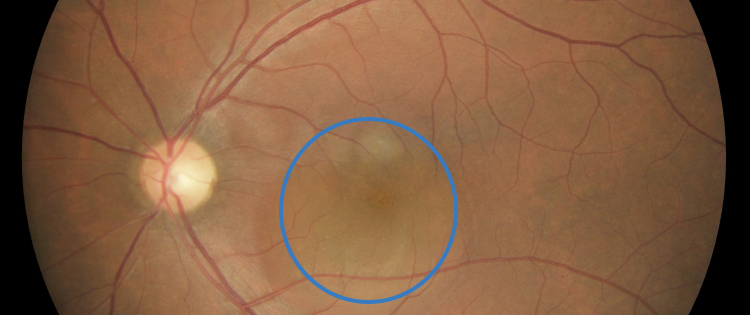What is central serous chorioretinopathy?
Central serous chorioretinopathy (CSCR) is also sometimes known as central serous retinopathy (CSR).
Central serous chorioretinopathy is a condition where fluid leaks under the retina.
The retina is the light sensitive tissue linking the back of the eye. CSCR is most often confined to the macula, which is that specialised part of the retina responsible for detailed central vision.
In CSCR, fluid collecting under the macula can lead to reduced or distorted vision
CSCR usually affects young to middle-aged adults. It’s more common in men than women. And it can affect one or both of your eyes.
In most cases, central serous chorioretinopathy spontaneously resolves within one to four months. However recurrences are common. Up to half of patients will experience CSCR again within a year of the first episode.

Symptoms of central serous chorioretinopathy
If you have central serous chorioretinopathy you may experience
- blurred or decreased vision
- distorted central vision, where lines appear crooked or bent
- a dark spot in your central vision
- objects appearing smaller or further away than they really are
- colours appearing washed out.
What causes central serous chorioretinopathy?
The exact causes of central serous chorioretinopathy aren’t fully understood. But we do know there are certain risk factors that may influence the development of CSCR. These include:
- elevated steroid levels – including steroids taken by mouth as tablets, through your skin as a cream, as an injection or inhaled as a nasal spray
- stress
- hypertension
- personality traits, such as type A personality (ambitious, competitive, impatient behaviour)
- pregnancy
- sleep disturbances, including sleep apnoea.
How is CSCR diagnosed?
Central serious chorioretinopathy is diagnosed during an eye examination by an eye health professional.
There are several tests that may be used to diagnose and monitor CSCR.
Optical coherence tomography (OCT)
An OCT scan is a quick, painless and non-invasive imaging technique. The scan uses light to produce very high-resolution cross-sectional images of the tissue layers of the retina.

Angiograms
In some cases, your eye health professional may use fluorescein and/or indocyanine green angiography. This involves specialised imaging of the retina following injection of fluorescein or indocyanine green dye into a vein in the arm.
Fluorescein is an orange dye. This dye is injected into the blood via a vein in your arm. The dye rapidly reaches the eye through the bloodstream and circulates through the retina. Your eye health professional will then use a special camera to take a series of images of your retina. This procedure only takes a few minutes.
An indocyanine green angiogram is where a green dye is injected into a vein in your arm in the same way as a fluorescein angiogram.
How is CSCR managed?
In most cases, your body will reabsorb the fluid leakage under the macula, without the need for treatment. This usually happens within one to four months. So, your eye health professional may just choose to monitor your condition.
Your optometrist or ophthalmologist may also recommend you stop or reduce steroids (if you are taking them). You should also try to control other risk factors, such as stress.
In a very small number of cases, your eye health professional may consider trialling oral medication to see if this helps.
If there’s no improvement after several months, your ophthalmologist may consider treatment with specialised lasers (argon laser photocoagulation or photodynamic therapy). This seals off the leakage and reduces the fluid under the retina.
After laser treatment, your eye health professional will monitor you closely. If CSCR recurs or signs and symptoms persist, you may need further treatment.
Complications and long-term effects of CSCR
Many people have complete resolution of their visual symptoms. In some, mild visual symptoms such as slight distortion and colour desaturation may persist, even after the fluid has been completely resorbed. Rarely, there can be development of a choroidal neovascular membrane, which may require further treatment.
Use an Amsler grid
If you have been diagnosed with CSCR it is important to monitor your vision carefully using an Amsler grid.
Contact your eye health professional immediately if you notice any sudden changes in your vision.
Prompt action can save your sight.
Get the fact sheet
The information on this page is available as a downloadable fact sheet.
Download the publication today.
Download








